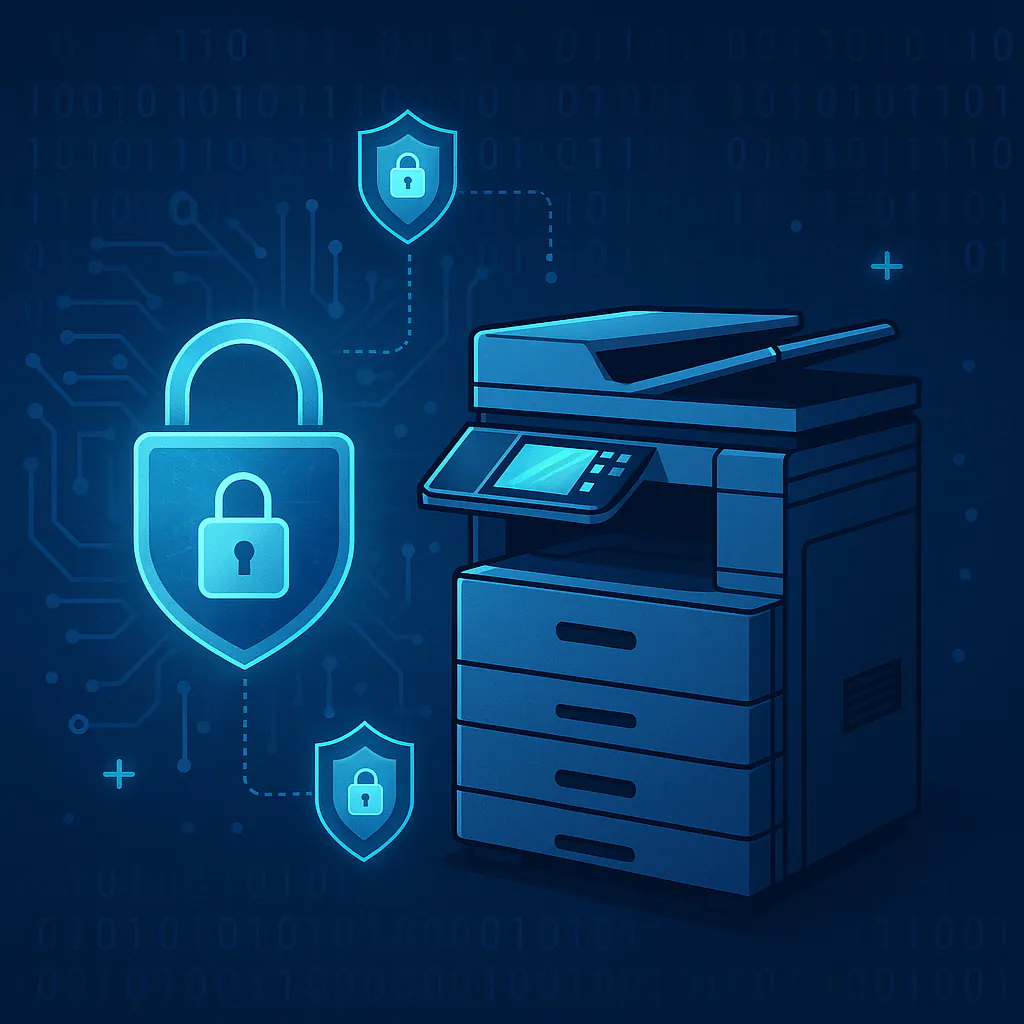If you think your office copier is just a printer with a few bells and whistles, think again. Today’s multifunction printers (MFPs) go beyond just being an office copier; they are powerful networked devices that scan, email, store, and process data, often sensitive and sometimes confidential. Yet many businesses overlook these devices as critical endpoints in their IT security plans.
In this deep-dive blog, we’ll answer a common but rarely understood question: “Is my office copier a cybersecurity threat?” Spoiler alert: yes, it is. And we’ll walk you through how to protect it.
Why Are Copiers a Security Risk?
Most modern copiers are multifunction printers (MFPs) connected to your network. That means your office copier can send and receive data, store documents, and often has hard drives and remote access capabilities.
Here’s why that matters:
- Stored Data: Many MFPs retain images of scanned, printed, or faxed documents on internal hard drives.
- Network Access: If your copier is connected to the same network as your computers and servers, it’s a potential entry point for cyberattacks.
- Weak Credentials: Default passwords or poor access controls make it easy for attackers to gain unauthorized access to your office copier.
- Outdated Firmware: Just like any other IoT device, copiers need regular security patches. Unpatched firmware leaves your office copier vulnerable.
- Remote Admin Tools: Features that make copier management convenient also make it easier for attackers to manipulate settings or exfiltrate data remotely.
Real-World Threats Targeting Copiers
Let’s break down some of the actual security risks that target MFPs:
- PJL Injection: Attackers use Printer Job Language commands to alter device settings or extract information.
- PrintNightmare Vulnerabilities: Windows-based print spooler exploits can allow remote code execution and privilege escalation.
- Credential Stuffing: If your copier uses the same login credentials as your network, compromised passwords can give hackers wide access.
- Data Interception: Unencrypted print jobs or scans can be intercepted during transmission from your office printer/copier.
- Hard Drive Harvesting: When copiers are retired or returned at lease-end, data left on internal drives can be retrieved if not securely erased.
7 Steps to Secure Your Office Copier
Securing your copier isn’t just an IT best practice—it’s a necessity. Here’s how to protect your organization:
1. Change Default Admin Passwords
This is cybersecurity 101, yet so many copiers operate with factory-set credentials. Make strong, unique passwords a baseline for your office copier.
2. Enable Data Encryption
Use TLS 1.3 or IPPS (Internet Printing Protocol over TLS) to encrypt data in transit. For stored data, look for copiers that support AES-256 encryption.
3. Implement User Authentication
Use badge readers or PIN codes to ensure only authorized users can access functions or release print jobs. This also supports pull printing protocols.
4. Apply Firmware and Security Updates Promptly
Patch management is crucial. Schedule regular updates for your office copier or enable auto-updating where supported.
5. Segment Your Network
Place copiers on a separate VLAN to isolate them from mission-critical systems. This limits lateral movement during an attack.
6. Wipe Internal Storage Before Disposal or Lease Return
Use the secure erase function to wipe all stored data in your office copier. This is especially critical for regulated industries.
7. Use Print Management Software
Tools like PaperCut or uniFLOW allow for monitoring, auditing, and access control, reducing both risk and waste.
What Happens If You Ignore This?
Let’s say you skip these steps. What could go wrong?
- Data Breach: Sensitive customer or employee data could be exposed.
- Compliance Violations: HIPAA, GDPR, and other regulations can fine you for poor data practices.
- Network Compromise: Attackers can pivot from an unsecured copier to more sensitive internal systems.
- Reputation Damage: A preventable breach through an office copier looks especially negligent to clients and regulators.
Hypothetical Scenario: The Copier That Opened the Door
Imagine a regional healthcare provider leasing a fleet of MFPs. The devices were never reconfigured beyond default settings. One night, a cybercriminal gains access via a known firmware vulnerability in an office copier. Because the copier shared a network with patient records, the attacker exfiltrated sensitive health data, triggering HIPAA violations, a public breach notification, and a class-action lawsuit.
All of it could have been prevented with basic copier hardening.
Why Partnering with Doceo Helps
At Doceo, we don’t just sell or lease copiers. We secure them as an essential part of your office copier strategy. From implementing encrypted data flows and user authentication to configuring firmware lockdown and secure disposal policies, our team ensures that your MFPs are an asset, not a liability.
We specialize in:
- Personalized print security assessments
- Integration of print devices into your IT security framework
- Ongoing maintenance and compliance support
Our approach isn’t one-size-fits-all. It’s grounded in real-world experience and tailored to your environment.
Final Thoughts: Copiers Are Endpoints. Treat Them That Way.
If your cybersecurity policy doesn’t include your copiers, it’s incomplete. These devices store, transmit, and process data just like laptops (Lenovo, Dell) and servers. Your office copier needs protection, monitoring, and a plan for lifecycle management.
Next Step: Don’t wait for a breach. Schedule a print security audit with a Doceo specialist today. Call us at 888-757-6626 or read blogs to learn how we protect every print environment—start to finish.
Also, Checkout – Component Risk Management





